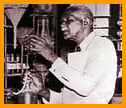
 |
| EnchantedLearning.com Food Activities and Information |
Click Here for K-3 Themes |
Food: Inventions and Inventors
| CAN AND CAN OPENER The can opener was invented in 1858 by Ezra Warner of Waterbury, Connecticut, USA. Warner's device used a lever and chisel. Until then, cans were opened using a hammer and chisel; the can opener was invented 50 years after the metal can was invented. The can opener was improved in 1870 by William Lyman of West Meridian, Connecticut, USA. Lyman's device used a rotating wheel and a sharp edge. His can opener only fit one size of can, and first had to pierce the center of the can. The modern-day type of can opener (using a serrated wheel) was invented in 1925. |
CARVER, GEORGE WASHINGTON George Washington Carver (1865?-1943) was an American scientist, educator, humanitarian, and former slave. Carver developed hundreds of products from peanuts, sweet potatoes, pecans, and soybeans; his discoveries greatly improved the agricultural output and the health of Southern farmers. Before this, the only main crop in the South was cotton. The products that Carver invented included a rubber substitute, adhesives, foodstuffs, dyes, pigments, and many other products. George Washington Carver (1865?-1943) was an American scientist, educator, humanitarian, and former slave. Carver developed hundreds of products from peanuts, sweet potatoes, pecans, and soybeans; his discoveries greatly improved the agricultural output and the health of Southern farmers. Before this, the only main crop in the South was cotton. The products that Carver invented included a rubber substitute, adhesives, foodstuffs, dyes, pigments, and many other products.
For more information on Carver, click here. For a cloze (fill-in-the-blank) activity on Carver, click here. |
| CRUM, GEORGE The potato chip was invented in 1853 by George Crum. Crum was a Native American/African American chef at the Moon Lake Lodge resort in Saratoga Springs, New York, USA. French fries were popular at the restaurant and one day a diner complained that the fries were too thick. Although Crum made a thinner batch, the customer was still unsatisfied. Crum finally made fries that were too thin to eat with a fork, hoping to annoy the extremely fussy customer. The customer, surprisingly enough, was happy - and potato chips were invented! For more information on George Crum and potato chips, click here. |
| POTATO CHIPS The potato chip was invented in 1853 by George Crum. Crum was a Native American/African American chef at the Moon Lake Lodge resort in Saratoga Springs, New York, USA. French fries were popular at the restaurant and one day a diner complained that the fries were too thick. Although Crum made a thinner batch, the customer was still unsatisfied. Crum finally made fries that were too thin to eat with a fork, hoping to annoy the extremely fussy customer. The customer, surprisingly enough, was happy - and potato chips were invented! For more information on George Crum and potato chips, click here. |
| All Themes | Animals | Food | People | Plants | Sports | Time and Calendar | Holidays |
|---|
| A | B | C | D | E | F | G | H | I | J | K | L | M | N | O | P | Q | R | S | T | U | V | W | X | Y | Z |
Enchanted Learning®
Over 35,000 Web Pages
Sample Pages for Prospective Subscribers, or click below
|
Overview of Site What's New Enchanted Learning Home Monthly Activity Calendar Books to Print Site Index K-3 Crafts K-3 Themes Little Explorers Picture dictionary PreK/K Activities Rebus Rhymes Stories Writing Cloze Activities Essay Topics Newspaper Writing Activities Parts of Speech Fiction The Test of Time
|
Biology Animal Printouts Biology Label Printouts Biomes Birds Butterflies Dinosaurs Food Chain Human Anatomy Mammals Plants Rainforests Sharks Whales Physical Sciences: K-12 Astronomy The Earth Geology Hurricanes Landforms Oceans Tsunami Volcano |
Languages Dutch French German Italian Japanese (Romaji) Portuguese Spanish Swedish Geography/History Explorers Flags Geography Inventors US History Other Topics Art and Artists Calendars College Finder Crafts Graphic Organizers Label Me! Printouts Math Music Word Wheels |
Click to read our Privacy Policy
| Search the Enchanted Learning website for: |
Copyright ©2000 EnchantedLearning.com ------ How to cite a web page